Note: This post is a compilation of the five-part series of research briefs on the initial Carbon Plan. They discussed the plan’s mandates for nuclear power and coal (Part 1), natural gas (Part 2), solar facilities, batteries, and upgrading transmission (Part 3), and onshore and offshore wind facilities (Part 4), and also the plan’s admission that adding more solar and wind generation would raise rates and harm job creation (Part 5).
Background and Introduction
At year’s end 2022, the North Carolina Utilities Commission (NCUC) released an initial “Carbon Plan” for future electricity generation in North Carolina. The NCUC issued this plan in response to a law passed in late 2021, House Bill 951. That law took Gov. Roy Cooper’s arbitrary, aspirational goal in certain executive orders to reduce the state’s carbon dioxide emissions from electricity generation by 70 percent around 2030 (and then to net zero by 2050).
What the law does that the governor would not, however, is institute extremely important protections for the grid and for electricity consumers.
Those protections in law include the following requirements that a plan approved by the NCUC must meet (emphasis added):
• be “reasonable“
• set forth the “least cost path … to achieve compliance”
• comply with “current law and practice” regarding “least cost planning of generation“
• “maintain or improve upon the adequacy and reliability of the existing grid”
They are in keeping with North Carolina’s longtime protections in law. Recognizing that “the rates, services and operations” of electric power utilities are “affected with the public interest,” the law makes it state policy to require “adequate, reliable and economical utility service to all of the citizens and residents of the State” as well as “the least cost mix of generation and demand-reduction measures which is achievable.”
The State of North Carolina has long recognized that least-cost, reliable electricity at the flip of a switch is in the public interest. By seeking the “reasonable,” “least cost path” to emissions reductions with “least cost planning of generation” that would “maintain and improve upon the reliability of the grid,” the text of the law seeking to reduce North Carolina’s electricity-based CO2 emissions recognizes the very same ideal.
This compilation discusses the implications of each individual mandate in the NCUC’s initial Carbon Plan and focuses on whether it would help keep the plan within the law’s all-important parameters. The mandates will be discussed in order of impact and significance to electricity consumers at the mercy of this decision rather than to the coterie of industry groups, special interests, and outside activist groups given the label “stakeholders.” At least North Carolina law has kept in focus that the top stakeholders in electricity policy are the consumers.
Coal: Close all coal power plants by 2035
Mandate:
- Requires Duke to optimally retire its remaining coal-fired generating units, more than 9,000 MW, by 2035
Retiring coal power plants is at the heart of the plan, because coal is the greatest source of CO2 emissions. Replacing these existing plants with different ones necessarily increases electricity costs. According to the Institute for Energy Research (see the graph), the levelized cost of existing coal-fired power plants is less than half that of new solar and wind facilities plus their required backup generation.
The Levelized Cost of Electricity from Existing and New Resources
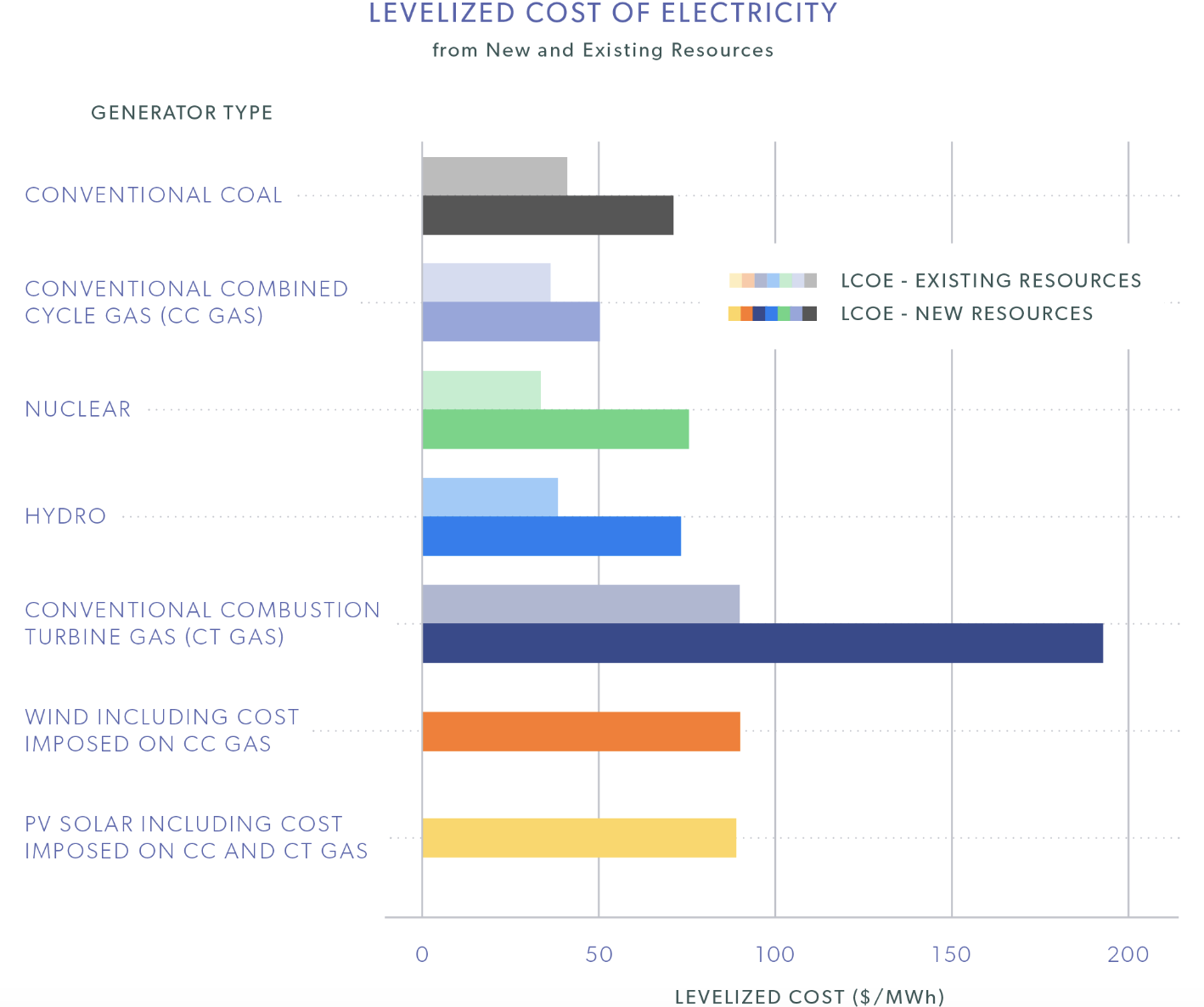
Source: Institute for Energy Research
The costs to Duke Energy of existing power plants are in operations and maintenance. Building new plants incurs capital costs on top of operations and maintenance. Those costs get passed through to electricity consumers on their power bills.
Closing coal plants would get rid of one-fourth of the state’s power supply. How the plan would replace all that generation capacity is extremely important.
The amount of coal generation to be retired is enormous; it represents one-fourth of the installed capacity in the state. How the plan would replace all that generation capacity is extremely important. It makes all the difference between whether the plan upholds its legal requirements to chart the least-cost path to emissions reductions that maintains or improves the reliability of the grid, or if it socks North Carolinians with electricity priced much higher than necessary while destabilizing the grid.
The mandate also forecloses the possibility of a breakthrough in carbon-capture technology. As a fuel source, coal is cheap, abundant, and reliable. With respect to the CO2 emissions reduction goals, the only problem with coal is its emissions. Meanwhile, companies in Cary and Charlotte have been awarded grants by the Biden administration’s Department of Energy to test carbon-capture technologies.
We cannot know for sure if that or some other disruptive innovation might make plentiful and inexpensive coal a low-emissions resource. Consider that, prior to the breakthrough combination of hydraulic fracturing and horizontal drilling in the late 2000s, low-emissions natural gas seemed hopelessly unable to compete with coal, but within a few years it had overtaken coal. Technological innovation happens fast, but government bureaucracy creeps.
Nuclear power: Keep what we have, look into getting more
Mandate:
- Requires Duke to seek to extend the licenses for its existing nuclear fleet, and authorizes Duke to incur project development costs associated with new nuclear generation
This is the most important aspect of the plan. Our current nuclear facilities are by far the lowest-cost, most efficient, fully zero-emissions generation source out there. There is absolutely no way to replace any of our preexisting nuclear generation with any other source of generation (even solar and wind) without making electricity cost more and emit more CO2. Retaining the nuclear fleet has for that reason been Locke’s top recommendation for energy and electricity policy.
New nuclear generation is the most sensible way to add new zero-emission generation that maintains grid reliability and keeps cost increases to a minimum.
The previously unheard-of blackouts of Christmas Eve 2022 underscored exactly how important nuclear power is to reliable generation:
Hourly Electricity Generation By Source in the Week Including the Christmas Eve Rolling Blackouts
Nuclear stayed steady throughout; solar provided only a few hours of production per day, only because it was sunny, and only after the early morning peak demand
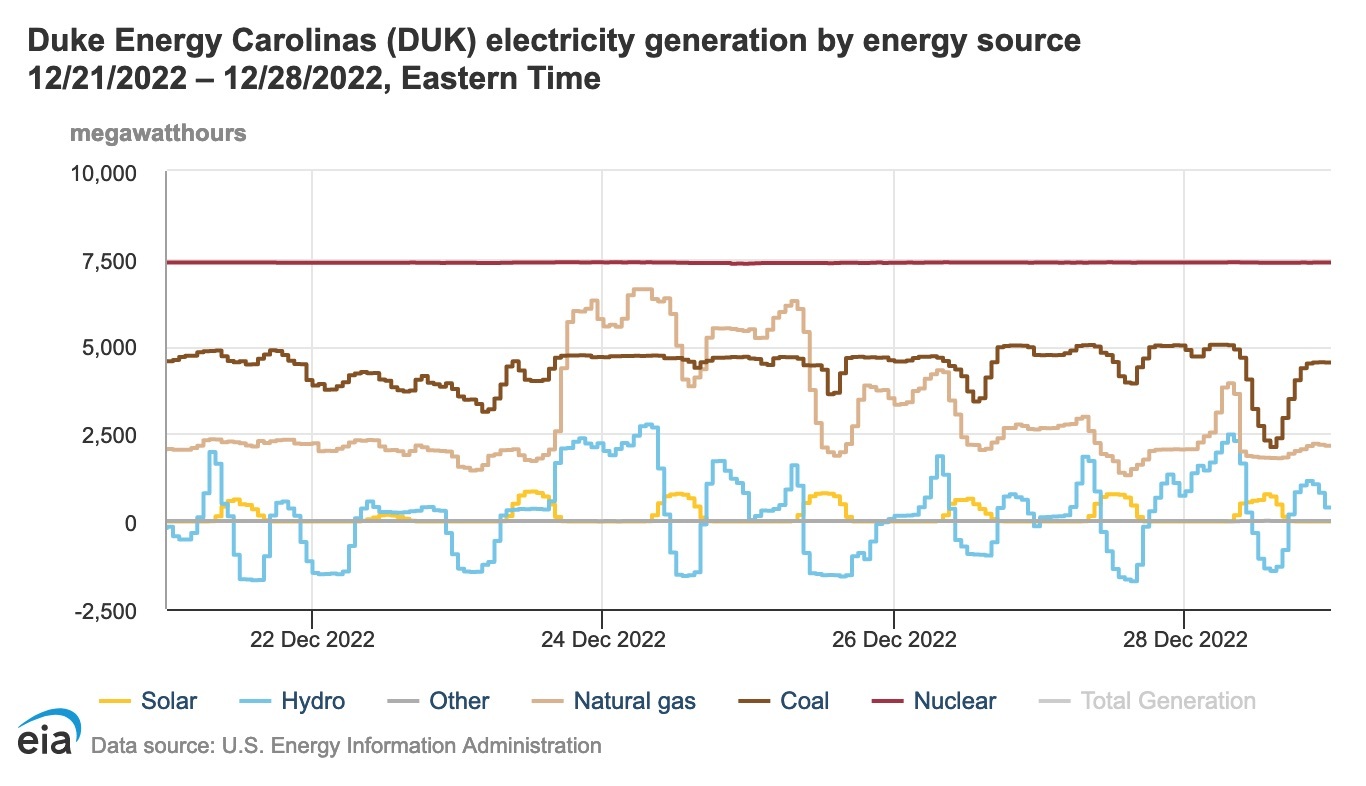
As can be seen in the graph above from the U.S. Energy Information Administration, which shows the hourly generation by Duke Energy’s different electricity sources, nuclear generation was steady throughout. At first glance one might even miss the line at the top of the graph showing nuclear generation, because it is so steady it looks like the chart’s upper bound and not a graph line in itself.
New nuclear generation is the most sensible way to add new zero-emission generation that maintains or improves grid reliability while keeping the costs of adding new generation reasonable and lower. New nuclear would be highly efficient and readily available, not weather-dependent like solar and wind. Because of that, there would be no need to overbuild as there is with solar and wind (add redundant facilities at enormous expense because they are so unreliable). It likewise requires a very small amount of land, especially in comparison with solar and wind facilities, even before considering having to overbuild solar and wind because of their unreliability.
The only thing lacking with this mandate is requiring that Duke must develop new nuclear generation. As will be shown later, the NCUC has no qualms against making such a mandate for procuring solar.
Natural gas: Plan to add more generation, and ensure more natural gas is available here
Mandate:
- Authorizes Duke to plan for the addition of combustion turbine and combined cycle natural gas-fired generating capacity, while requiring Duke to address concerns about the availability of firm transmission capacity to North Carolina in future proceedings
Adding more baseload (combined cycle, or CC) and peaker (combustion turbine, or CT) natural gas generation is very important since the plan aims to retire all coal-fired generation by 2035. It would remove over 9,000 megawatts (MWs) of power generation, which is one-fourth of North Carolina’s generation capacity. Coal is a baseload generation source.
With coal plants closing, the Carbon Plan needs natural gas — and new pipeline supplies — as the “bridge” fuel to keep the grid reliable and costs down while lowering emissions.
Electricity is consumed when it is produced, which is what makes baseload generation so vital. Power system engineers can do many things, but they cannot cause families and businesses to funnel their daily electricity needs within the few, variable, and unpredictable hours that weather-dependent resources such as solar and wind are able to produce. People’s electricity needs are variable throughout the day and week as well, and especially in the summer and winter they are affected by temperature extremes.
With so much baseload coal to be replaced, the relatively small amounts of CC and CT natural gas production the NCUC authorized Duke to plan for — only 1,200 MWs of CC and 800 MWs of CT — are perplexing. The NCUC’s decision was, however, heavily influenced by bad decisions at higher levels of government.
Looming over the discussion of natural gas production is, as stated in the plan, that North Carolina is “currently deficient of interstate pipeline firm transportation capacity due to the cancellation of Atlantic Coast Pipeline (ACP).” Furthermore, “the major interstate pipeline supplying the Carolinas is fully subscribed, and during the coldest winter days, the gas demand for electricity generation coincides with peak Local Distribution Company demand.”
The ACP was a major pipeline project of Duke along with Dominion Energy in Virginia, which would have brought natural gas supplies from West Virginia into those states. It was canceled in 2020 after years of weathering expensive environmental lawsuits, withheld and slow-walked permits, and other government shenanigans that caused it to become too costly to build. As to the latter, Carolina Journal’s Don Carrington provided a timeline of the ACP’s opponents’ machinations with the administration of Gov. Roy Cooper concerning the pipeline.
Another pipeline project that would traverse West Virginia and Virginia and make additional supplies available to North Carolina, the Mountain Valley Pipeline (MVP), has likewise been beset with court challenges and permit delays. MVP is about 94 percent completed and was originally supposed to be finished by 2020, but it now has a completion date of 2026.
Current supply deficiencies of natural gas are especially problematic for achieving the plan’s CO2 emissions reduction within the law’s strictures, not only setting the “least-cost path” to compliance, but more importantly ensuring the “adequacy and reliability of the grid.” As Duke testified before the commission, “delay of the new natural gas-fired resources would limit its ability to retire its existing coal units.”
The NCUC’s plan discussed the importance of natural gas as a “bridge to integrate more renewables and batteries” until sufficient zero-emissions resources “are available and can replace at scale what gas contributes to the system.” The idea of lower-emissions natural gas as the “bridge fuel” from high-emissions coal to zero-emissions generation and storage stretches back to at least the Obama administration (Pres. Barack Obama even used it in his 2014 State of the Union address). Pres. Joe Biden and his administration, however, have fought domestic natural gas from exploration to pipelines.
New nuclear plants would, as previously discussed, provide for reliable, zero-emissions, baseload generation. They take much longer to build, however, which the law acknowledged by allowing for an extension in reaching the interim emissions-reduction goal “in the event the Commission authorizes construction of a nuclear facility or wind energy facility that would require additional time for completion due to technical, legal, logistical, or other factors beyond the control of the electric public utility, or in the event necessary to maintain the adequacy and reliability of the existing grid.”
The law and the NCUC plan need natural gas as a bridge fuel as coal plants are retired in order to keep the grid reliable while staying on a least-cost path of lowering emissions from electricity generation. New natural gas CC and CT resources in the near term are, as stated in the plan, “essential to achieving the Interim Target [70 percent reduction of CO2 emissions], while maintaining or improving reliability, and doing so along a least cost path.” Given, however, the “significant uncertainty” of future access to additional natural gas resources “if the MVP is never completed or not timely completed,” the NCUC plan limited the amount of new natural gas capacity to only 2,000 MWs of CC and CT generation.
It’s not enough. North Carolinians therefore need the Biden administration and the Cooper administration to drop their self-defeating opposition to pipeline projects.
Solar: Hurry, buy now, spend on prepping the grid, and get some battery storage while you’re at it
Mandates:
- Directs Duke to conduct two competitive procurements between 2023-2024 targeting 2,350 MW of new solar generation to be placed into service by 2028
- Authorizes Duke to upgrade necessary transmission facilities to interconnect new solar generation
- Authorizes Duke to procure 1,000 MW standalone battery storage and 600 MW of battery storage paired with solar generation
While the NCUC plan authorizes Duke to (emphasis added) “incur project development costs associated with new nuclear generation” and “plan for the addition of … natural gas-fired generating capacity,” the plan directs Duke to go ahead and procure 2,350 MWs of new solar generation. Given the law’s focus on finding the least-cost path to CO2 emissions reductions that would at least maintain “the adequacy and reliability of the existing grid,” interconnecting that much solar would seem to present significant challenges to the grid.
Shortly after the plan was released, Duke requested a nearly 16 percent increase in customer bills by 2026 — mostly to pay for the transmission upgrades to procure so much solar so quickly.
Plus, the challenge is even greater than it appears in the plan, because on November 2022 the NCUC had — outside of the Carbon Plan — just directed Duke to procure 1,200 MWs of new solar generation. Solar’s advocates pushed for rapid interconnection of great amounts of new solar generation on what they called a “‘no regrets’ strategy,” by which they meant taking advantage of tax incentives in the misnamed “Inflation Reduction Act” of 2022.
The “savings” offered by those incentives would pale in comparison to the costs of the “substantial transmission upgrades required” to interconnect so much new solar so quickly. How much? Take the most solar Duke has ever interconnected in a single year — it would be, as noted in the plan, 2.5 times greater than that previous high:
Duke noted that adding this significant amount of new solar resources to its system will require the accelerated interconnection of solar resources at a rate of approximately 2.5 times that of the historic maximum amount of utility-scale solar that Duke has ever connected in a single year in the Carolinas.
The order to procure so much battery storage is necessary, as stated in the plan, “in addressing problems associated with intermittent energy resources such as solar [photovoltaic] and wind generation.” Nevertheless, “cost-effective long duration storage solutions” are yet to be realized, though the plan seems to anticipate that battery technologies will someday “evolve” to that. Incidentally, should that happen, it would mean that the short-term battery storage ordered now to “address the problems associated with” this rushed new solar generation would be stranded assets, the passed-through costs of which would still impact electricity consumers.
To illustrate this problem, look at this graph from the U.S. Electricity Information Administration’s grid monitoring site. It shows the hourly performance of Duke Energy Carolinas’ different energy sources during the week of January 8–14, 2023. The variable brown line that rarely dips below 2,000 megawatt-hours (MWhs) of generation is coal, which the plan would replace. Those yellow camel’s humps in the middle of the days represent solar generation over a few hours in the day, depending on the sunshine. The rest of the time, however, solar stays at 0 megawatt-hours (MWhs) — battery storage would try to fill in those gaps. (The top red line is not the graph’s upper bound; it is steady, reliable, zero-emissions nuclear, hovering close to 7,400 MWhs.)

On January 19, Duke requested that the NCUC approve a nearly 16 percent increase in customer bills by 2026, including a 9.5 percent increase next year. Duke’s large request is mostly to pay for the transmission upgrades made necessary by the NCUC’s order that they procure such a huge volume of solar so quickly: “75% of spending over next three years consists of electric grid infrastructure improvements.”
If the utility has to (a) spike consumer bills right away in order to (b) rebuild the transmission system so as to (c) interconnect unreliable, nondispatchable renewable energy generation in part because it isn’t allowed to (d) replace reliable baseload generation (coal) fully with other reliable baseload generation sources (nuclear and natural gas), are we still supposed to think the plan is upholding its legal requirements? Are legislators?
Is this outcome the “reasonable,” “least cost path” to emissions reductions with “least cost planning of generation” that would “maintain and improve upon the reliability of the grid”? It’s not even been a month.
Wind: Start planning for onshore facilities, and see if you can make offshore wind feasible
Mandates:
- Directs Duke to engage with onshore wind stakeholders and economically model utility-owned onshore wind in its next round of modeling
- Directs Duke to study and consider the acquisition and development of wind lease areas off the coast of North Carolina
The NCUC found the pursuit of onshore wind generation compelling given that “[e]very portfolio in Duke’s Carbon Plan proposal,” including two supplemental plans, “selected 600 MW of onshore wind.” The commission found that “the characteristics of onshore wind make it a compelling complement to solar generation that could help foster system reliability.” What that means is that wind can blow when the sun isn’t shining, and the sun can shine when the wind isn’t blowing. It would hardly be unusual, however, for sun and wind both to be absent.
Adding wind capacity to solar just adds a different layer of unreliability and intermittency. Overbuilding a redundancy of unreliability is not the same as efficient, reliable generation, nor would it be least-cost.
In other words, onshore (and offshore) wind adds a different layer of unreliability and intermittency to solar’s unreliability and intermittency. This redundancy of unreliability is not the same as efficient, reliable generation, though. By way of comparison, the model “Least-Cost Decarbonization” portfolio submitted to the NCUC by Locke’s Center for Food, Power, and Life (CFPL) was able to accomplish the law’s emissions-reduction targets without any wind generation.
Nevertheless, the NCUC ordered Duke to “engage with onshore wind stakeholders and economically model” wind because the commission was unsure “whether Duke can reasonably put into service 600 MW of utility owned onshore wind in order to achieve the Interim Target” (of 70 percent CO2 emissions reductions by 2030). “Stakeholders” is a mercenary term for groups who stand to profit from government forcing an option on captive ratepayers. As the CFPL vision statement puts it,
Too often in the public-choice wrangling among “stakeholder” cronies and special interests, policymakers can lose sight of who the main stakeholders are, the ones with the most at stake: we the people.
Onshore wind generation is very expensive, needs costly transmission upgrades, and also requires by far the largest amount of land. Just to produce 1,000 MWs of generation, onshore wind would require a larger land footprint than Mecklenburg County. For the same amount of generation that takes onshore wind 576 square miles to produce (when the wind is blowing), natural gas needs only two square miles. And nuclear? Only a half square mile.
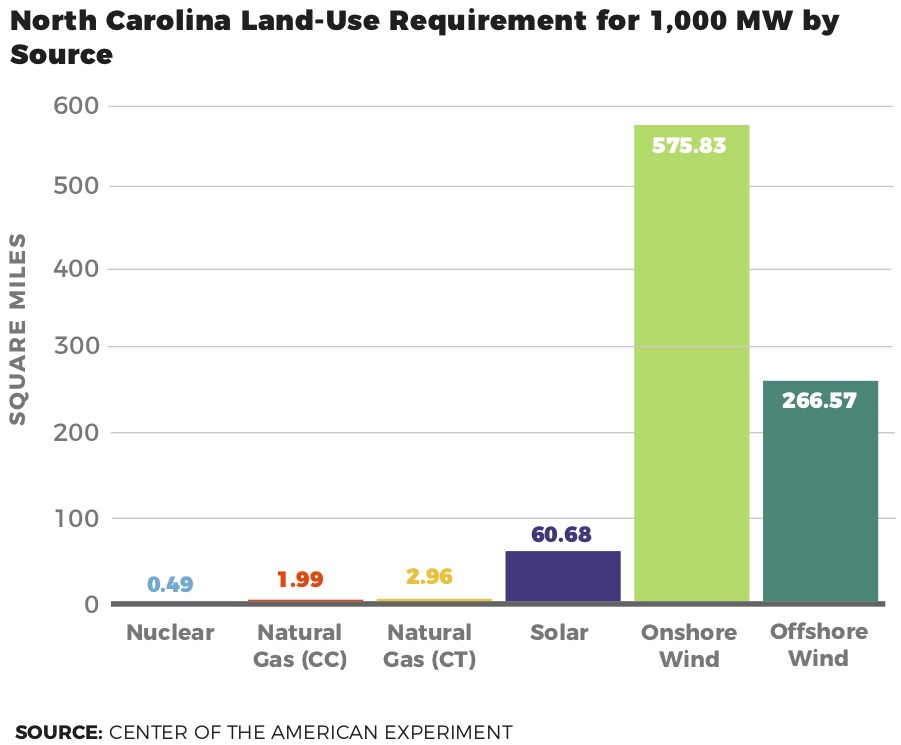
One thing that is more expensive than onshore wind generation, however, is offshore wind generation. Several aspects of offshore wind caused the NCUC to ask for a study rather than order Duke to dive right in. They include a “near-term cost” to Duke of offshore wind development of $317.4 million, the uncertainty of the capacity factors (how much output could be expected) of any developed wind energy area offshore, the fact that the Kitty Hawk wind energy area would require “roughly 100 miles of additional cabling,” the uncertainty of whether Kitty Hawk could even be developed to benefit Duke’s customers, and the unique threat of hurricanes off the coast of North Carolina (other offshore wind sites don’t have the hurricane activity that North Carolina does), among other things.
Those costs of offshore wind extend well beyond the capital and construction costs, however, even as those alone would significantly add to consumers’ power bills as those costs get passed through to Duke’s customers. As CFPL demonstrated, the costs of offshore wind include:
- Tens of thousands of jobs owing to electricity price hikes alone
- Major damage to coastal communities’ largest industries: fishing and tourism
- Significant increase in North Carolina’s already dangerous level of energy poverty
- Ominous threats to marine wildlife, including dozens of endangered species, and also seabirds, gulls, and endangered migratory birds
Ugly arrays of turbines gashing the viewshed that beachgoers enjoy would distinctly harm coastal tourism, as North Carolina State researchers found. Their study of beach tourists’ sensitivity to visible wind turbines involved turbines over 500 feet tall. The Carbon Plan noted, however, “opportunity to create larger and taller wind towers.” The turbines under discussion now are over 1,000 feet tall. By way of comparison, the Bank of America Corporate Center in Charlotte (the state’s tallest building), which is visible from Grandfather Mountain, is 871 feet tall.
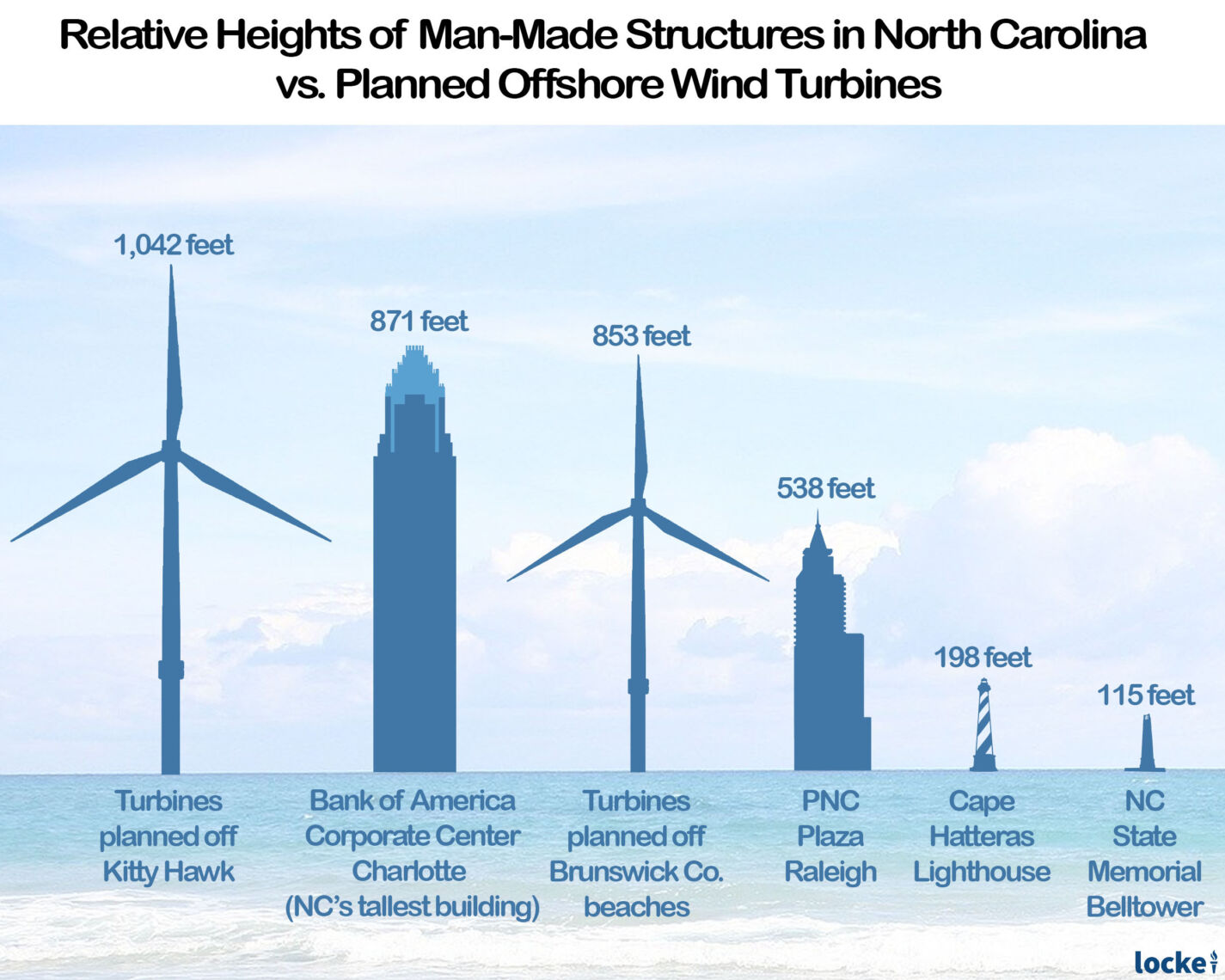
Offshore wind’s costs are staggering for a fickle electricity generation source that only works when the wind is blowing within certain speeds — something grid operators can only hope coincides with people’s need for electricity at the moment. Duke won’t be upset if the NCUC orders them to build large amounts of depreciable capital assets paid for by ratepayers, but even if the commission tosses aside their “least cost” strictures, North Carolina’s electricity consumers ought to be able to expect them to maintain the reliability of their power. Not this:
Europe is already showing what happens to people when governments heedlessly discard dispatchable power generation for electricity at nature’s whim. Last year’s European “wind drought” was a warning. Forecasts for the upcoming winter predict exceptional cold. Worse, the dreaded “Dunkelflaute” is setting in again, the “dark doldrums” of still air (no wind) and little sunlight in the winter months.
Burdening the grid with so much weather-dependent renewable resources, solar and wind, harms reliability so much that it makes demand spikes from weather extremes not the only — or even the worst — threat to grid reliability, but dull days “when weather-dependent generation is impacted by abnormal atmospheric conditions or when extreme conditions disrupt fuel supplies”:
The looming threat of a dull day is something warned about in a new report from the Colorado Public Utilities Commission. … As reported by Colorado Public Radio, more solar and wind facilities on the grid would mean that “long periods of still, overcast weather,” rather than extreme temperature events, pose the greatest challenge. As report author Nicholas Garza put it, “What we would think of as very benign or very boring weather, where you have just persistent cloud coverage and really no wind, that’s actually going to pose the most significant threat.”
North Carolina’s Utilities Commission should rethink forcing expensive onshore and offshore wind generation on the grid. North Carolinians deserve better — and the law demands better for them — than to pay significantly higher rates to support generation sources that put their power at risk even in “boring weather.”
Carbon Plan admission: More solar, more wind, and more transmission upgrades to support them mean much higher rates
The initial Carbon Plan discusses various generation sources and mandates Duke Energy to plan to either retire them (coal), procure them right away (solar), look into adding some (natural gas), start project development for adding some (nuclear), and model and study adding some (onshore and offshore wind).
Elsewhere, however, the initial plan acknowledges that more solar and wind generation will be more expensive. Is that surprising?
Duke Energy Progress (DEP) customers pay 19% higher rates than Duke Energy Carolinas (DEC) customers. Why? Because of DEP’s “significantly greater amount of solar generation [and] associated transmission and distribution system upgrades” vs. DEC’s “higher percentage of low fuel cost nuclear generation.”
The plan acknowledges a large rate disparity between Duke Energy Progress (DEP, which operates primarily on the eastern side of the state) and Duke Energy Carolinas (DEC, mostly western). While a DEC residential customer would be charged $106.23 for 1,000 kilowatt-hours (kWh) of electricity, a DEP customer would be billed $125.94 for the same amount. In other words, DEP customers pay 19 percent more for electricity than DEC customers. Why? That’s a good question.
DEP and DEC are “separate utilities, each possessing a unique service territory, customer base, and generation, transmission, and distribution assets.” Testimony from the Public Staff “points to the impact of the significantly greater amount of solar generation developed in DEP’s service territory, along with associated transmission and distribution system upgrades, as a likely significant driver of the current disparity” in rates between DEP and DEC. At the same time, “DEC has a higher percentage of low fuel cost nuclear generation than DEP has.”
In sum: DEC has more nuclear, less solar, and less need of rebuilding transmission and distribution systems to interconnect with solar than DEP. So DEC customers have significantly lower bills than DEP customers.
Geography means this rate disparity between DEP and DEC would worsen with interconnecting more renewables. It makes more sense to place solar facilities in the coastal plain (eastern NC — DEP’s territory). The same goes for onshore wind, and of course for offshore wind. So procuring large amounts of new solar generation and adding wind generation would hit DEP customers much harder.
The reason for the NCUC to discuss solar’s impact already on the significant higher electricity rates faced by DEP customers is that “DEP’s service territory will continue to be the likely location for much, if not all of the solar, Solar Plus Storage, and onshore wind resource development, and any offshore wind generation will require significant transmission development and upgrades on DEP’s system.”
The high electricity costs from DEP having to take on disproportionately more solar and wind would make it “increasingly difficult to recruit new economic development” and worse, “likely drive out existing businesses.”
Public Staff noted that DEP’s customers would “absorb a disproportionate share of the costs to achieve statewide compliance with the Carbon Plan,” but the damage would not stop there. The resulting much higher electricity rates could make it “increasingly difficult to recruit new economic development into DEP’s service territory.” Worse, “the higher electricity costs will likely drive out existing businesses.”
DEP’s customer base would face proportionately higher rates than DEC customers and the loss of jobs and employers to lower statewide CO2 emissions from electricity through adding expensive, unreliable renewable sources. Do these revelations not cause the NCUC to rethink solar and wind mandates? What about zero-emissions, highly reliable nuclear generation? What is the plan’s answer to this dilemma?
The plan’s proposed solution to this problem was not to rethink the rush into solar and planning for more onshore and even offshore wind generation. It was to declare it “appropriate for Duke to pursue a merger of DEC and DEP.” Even so, the NCUC would not “prematurely judge the prudency of the proposal.”
So as far as the plan is concerned, regardless of the “least cost path” standard in law, higher rates from interconnecting solar and wind facilities are coming. The only question, then, is whether those rate hikes will be distributed equally across the state.
In our analysis before the NCUC, the Locke Foundation’s Center for Food, Power, and Life (CFPL) showed that such a presumption is entirely off-base. We demonstrated that, in comparison with plans before the commission, a lower-cost path to the compliance with the law’s CO2 emissions reduction goals could be charted without hobbling the grid and ratepayers with more weather-dependent, unreliable solar and wind generation. Our analysis showed it could be achieved by adding more zero-emissions nuclear power, pumped storage, battery storage, and natural gas facilities:
Model Least-Cost Decarbonization Portfolio: Nuclear, Pumped Storage, Battery Storage, and Natural Gas
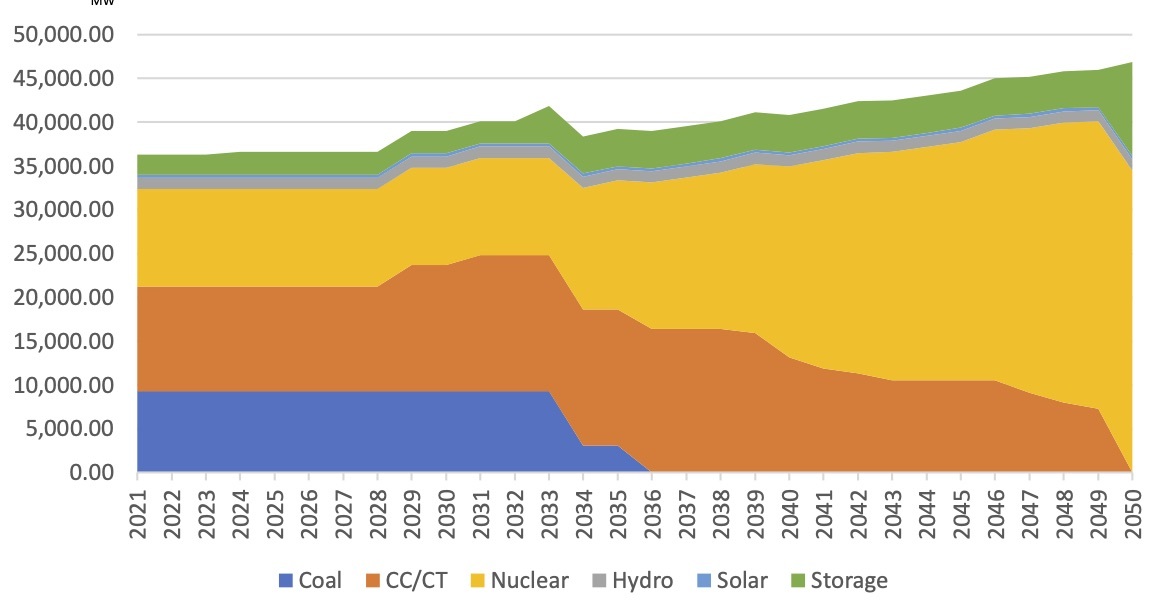
The drive to add more unreliable, expensive renewable energy sources — no matter how politically favored they are — cannot take prominence over the all-important safeguards written in North Carolina law.
The law requires the plan to result in a “reasonable,” “least cost path” to emissions reductions with “least cost planning of generation” that would “maintain and improve upon the reliability of the grid.” What do we get from the plan?
- Admitting that, because of already interconnected solar and less nuclear, DEP’s rates are 19 percent higher than DEC’s
- Acknowledging that the bulk of new solar and wind generation would be absorbed into the DEP resource mix
- Admitting that doing so would increase rates disproportionately on DEP customers, furthering the gulf between DEP and DEC rates and harming job creation in DEP territory
- Considering merging DEP and DEC in order to spread out the rate impacts
- Presuming those rate impacts by determining, despite the law, not to rethink adding expensive new solar and wind
As the CFPL analysis showed, and as the law expects, there’s a better way.


